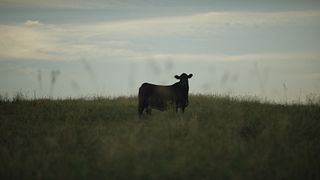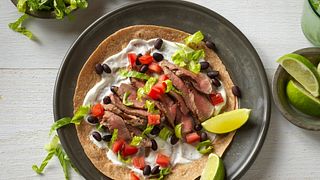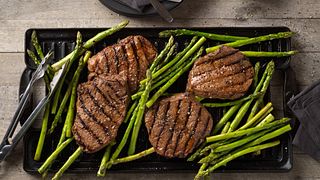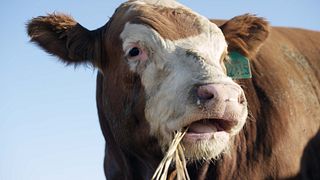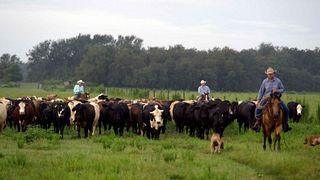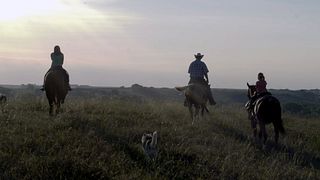BEEF’S ROLE IN GREENHOUSE GAS EMISSIONS
Contrary to some of the misconceptions about beef’s role in greenhouse gas emissions, cattle-generated gases are completely natural, are very different from the types of gasses stemming from fossil fuel emissions, and are on the decline.
In general, the biogenic carbon cycle is a naturally occurring process where carbon is utilized, recycled, and stored in different states. In nature, plants take in sunlight and carbon dioxide, and use it to create carbohydrates in a process called photosynthesis. Cattle then eat the plants and digest the carbon that is stored in the plants, undergoing a process called enteric fermentation.
Cattle are ruminant animals meaning that microbes in their stomach breakdown carbohydrates through the fermentation process. Ruminant animals, including sheep, goats, buffalo, elk and deer, have a unique four compartment stomach to help break down food. The rumen is the largest of these four compartments, filled with microorganisms that help break down foliage like grass.
This process creates gasses such as methane. This methane is then belched out – not through flatulence. After approximately ten years, methane is broken down in the atmosphere and converted back to carbon dioxide which plants can take in, thereby completing the carbon cycle.1,2
Greenhouse gases associated with the beef industry include carbon dioxide, methane, and nitrous oxide. However, there’s a clear difference between biogenic carbon (described above), and carbon from fossil fuels. While the biogenic carbon cycle happens on a short time scale, the cycle of carbon from fossil fuels takes 1,000 or more years. This is because carbon from burning fossil fuels comes from deep geological reserves (e.g. deep soils) that take thousands of years to be redeposited after being released. Therefore, while biogenic carbon has a short-lived impact on our climate, carbon from fossil fuels has a longstanding, and much more significant impact on the environment.3
While there’s a large focus on methane emissions from beef, it is not possible to eliminate all methane production from cattle and eliminating cattle would be undesirable for many reasons. One of which is their ability to take otherwise wasted materials and turn it into a high-quality protein through an upcycling process. This process allows cattle to eat materials that are inedible to humans (such as brewers’ grains, pea pulp and potato peelings) and turn it into a high-quality, nutrient-rich product to help feed a growing population.
An Ongoing Journey
Sustainability is an ongoing journey. Between 1961 and 2019, the U.S. beef industry, through continued sustainability efforts and improved resource use, has reduced emissions per pound of beef produced by more than 40% while also producing more than 67% more beef per animal.5 Emissions from cattle, including those that come from the feed production, fuel, and electricity account for 3.7% of the total greenhouse gas emissions in the U.S.4 Currently, emissions from U.S. beef cattle are less than 0.5% of the world’s greenhouse gas emissions.4,6 In fact, emissions from beef cattle represent 2.2% of total U.S. greenhouse gas emissions.4 These numbers will likely continue to decrease as farmers and ranchers seek to reduce methane emissions further through best management practices, including grazing management and feed supplementation.
The beef production system works in harmony to produce a more sustainable product, balancing all of the trade-offs that come with it. The beef production system is not only a net contributor (meaning the beef production system produces more protein than it consumes) to the human edible protein supply, but the quality of human edible protein produced is improved, meaning that it is more easily digestible by humans.8 However, a tradeoff of this upcycling superpower is that cattle produce methane during the digestive process. It is important to consider all tradeoffs when evaluating sustainability, as each component of the supply chain plays a unique and important role in healthy, sustainable beef production.
The entire beef community continues to make strides in improving its sustainability. It’s important to recognize that there are inherent trade-offs to the many ways in which cattle contribute to a sustainable food supply. It is important to recognize this balance when considering the sustainability of beef production, and its environmental, economic, and social contributions to society.
Please visit beefresearch.org for additional in-depth beef sustainability information.
Subscribe to our newsletter so you don't miss the best recipes, cooking tips, and more.
Privacy Policy- Wuebbles, D.J. and K. Hayhoe. 2002. Atmospheric methane and global change. Earth-Sci. Rev. 57:177-210
- IPCC. 2013. Climate Change 2013: The Physical Science Basis. Contribution of Working Group I to the Fifth Assessment Report of the Intergovernmental Panel on Climate Change [Stocker, T.F., D. Qin, G.-K. Plattner, M. Tignor, S.K. Allen, J. Boschung, A. Nauels, Y. Xia, V. Bex and P.M. Midgley (eds.)]. Cambridge University Press, Cambridge, United Kingdom and New York, NY, USA.
- Lynch, et al. 2020. Demonstrating GWP*: a means of reporting warming-equivalent emissions that captures the contrasting impacts of short- and long-lived climate pollutants. Environmental Research Letters 15(4).
- Beef Research. 2021. Quick Stat Calculations - Sustainability Research: Emissions. https://www.beefresearch.org/programs/beef-sustainability.
- Beef Research. 2021. Quick Stat Calculations - Sustainability Research: Statistics on U.S. Improvements in Beef Production and Emission Intensity. https://www.beefresearch.org/programs/beef-sustainability.
- IPCC, 2014: Climate Change 2014: Synthesis Report. Contribution of Working Groups I, II and III to the Fifth Assessment Report of the Intergovernmental Panel on Climate Change [Core Writing Team, R.K. Pachauri and L.A. Meyer (eds.)]. IPCC, Geneva, Switzerland, 151 pp.
- EPA. 2021. Inventory of U.S. Greenhouse Gas Emissions and Sinks: 1990-2019. U.S. Environmental Protection Agency, Washington, D.C.
- Baber, JR et al. 2018. Estimation of human-edible protein conversion efficiency, net protein contribution, and enteric methane production from beef production in the United States. Translational Animal Science 2(4): 439-450.
